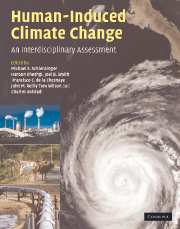Part IV - Policy design and decisionmaking under uncertainty
Published online by Cambridge University Press: 06 December 2010
Summary
Introduction
The ultimate goal of nearly all climate research, and certainly the motivation behind government investments in climate research, is to develop effective and efficient approaches for addressing climate change. Climate change is not just an environmental issue – it is an energy issue and an economic development issue. Global in extent, it is characterized by its century scale as well as substantial uncertainties in science (highlighted in earlier chapters of this book) and economics.
This section examines a number of important issues in climate policy. While not comprehensive, the chapters tackle many of the critical factors that are likely to drive climate policies.
In Chapter 25, Billy Pizer addresses the fundamental question of how climate policy should change given real uncertainty about climate impacts and in fact, most dimensions of the climate problem. Does the presence of uncertainty imply different policy prescriptions than if uncertainty were absent or modest?
In Chapter 26, Mikiko Kainuma and colleagues present a suite of disaggregated models, collectively known as the Asia–Pacific Integrated Model, used to formulate climate policy in the Asian region, particularly Japan. The chapter demonstrates the usefulness of the model in looking at specific policies to mitigate greenhouse gas emissions.
In Chapter 27, W. David Montgomery and Anne Smith take a closer look at policies to induce innovation in technologies for abating carbon or otherwise reducing emission of greenhouse gases. The authors argue that imposing a cost on emitting carbon is, by itself, ineffective at catalyzing fundamental technological advances.
- Type
- Chapter
- Information
- Human-Induced Climate ChangeAn Interdisciplinary Assessment, pp. 303 - 304Publisher: Cambridge University PressPrint publication year: 2007



